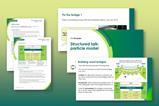Talking activities that give a deeper understanding of practical work
Chemistry can be regarded from three levels: macroscopic, sub-microscopic and representational. Together, these levels are known as Johnstone’s triangle.

Trained chemists move between these levels instinctively. Alex Johnstone wrote that, for a trained chemist, the electrolysis of copper chloride solution ‘brings on a mental picture of positive copper ions and negative chloride ions migrating in opposite directions picking up or losing electrons and discharging at the electrodes as copper crystals and chlorine gas molecules.’
However, students’ understanding of the electrolysis of copper chloride solution needs to be guided through the levels – from observations to the action of particles, which in turn may be represented by chemical equations and half equations. At the macroscopic level, the electrolysis of copper chloride solution means observing a pink-brown solid form on the cathode and gas bubbles form at the anode that bleach damp blue litmus paper. The sub-microscopic level depicts the particles – the atoms, molecules, ions and electrons – we use to explain why the electrolysis of copper chloride solution produces copper metal and chlorine gas. Finally, at the representational level, we communicate substances with symbols and formulae, and describe the changes observed with equations.
By teaching the three levels explicitly and rehearsing their use through talk activities you can support students in moving between these levels.
Furthermore, talk activities allow students to collaboratively explore and construct their understanding of a practical experience. They also allow teachers to offer real-time feedback to mitigate miscomprehension. I have found a talking approach works well for supporting my students’ understanding of practicals, such as the electrolysis practical required for GCSE qualifications. In all of the activities, students work in groups of three, called talk triplets.
Talking points
Give talk triplets a ‘talking point’ as a discussion stimulus. Two students discuss the talking point and the third then summarises and critiques.
‘Explain the electrolysis of copper chloride solution’ would be a talking point for considering electrolysis at the sub-microscopic level. Ask students to talk through, analyse and evaluate relevant ideas and come to a consensus. In particular, task students to take turns and build on and challenge each others’ ideas to reach a consensus. Person A begins the discussion ‘I think that …’, person B builds on from A, ‘Linking to that … ’, and lastly person C summarises ‘The main points were … .’
Spread talking points for a practical over a series of lessons rather than all in one lesson. I keep my students in the same trios to ensure they rotate roles each lesson. It may help to provide prompts to help students put their ideas together. These may be sentence stems or images.

Talking point prompts
Download these prompts for talking points (ppt or pdf) you can use to help students discuss the electrolysis of copper chloride at the macro-, sub-micro-, and representational levels.
Summary bullseye
Summary bullseye is a talk technique that scaffolds language acquisition. You can use this activity as a plenary to peer-assess understanding. It also makes a great revision activity breaking up past paper question activities.
Talk triplets test themselves by competing to obtain the highest score. They must correctly incorporate certain words, symbols or images into a summary, for example of the electrolysis of copper chloride. Points are deducted for incorrect use of a term, and the individual with the highest score wins. Students can keep scores to see their progress or to determine which level of representation they struggle with most.
Students can find it difficult to put images and symbols into a sentence, so model the process first. I suggest students begin by using summary bullseye to rehearse subject-specific vocabulary or a summary at the macroscopic level before applying this process to all levels of representation.

Bullseye
Download the summary bullseye game (ppt or pdf).
Students may require some additional support to articulate their ideas or understand the images. Download these slides (ppt or pdf) and use them to prompt and scaffold talk.
Further resources
- My talking points are inspired by the University of Cambridge oracy toolkit. Find further resources for talk activities on their website.
- I discovered the Summary bullseye game through Voice21, a network that promotes oracy teaching and learning.
- The Best evidence science teaching resources (BEST) also help students understand concepts from all levels of Johnstone’s triangle.
Downloads
Talking points
PowerPoint, Size 0.68 mbTalking points
PDF, Size 0.18 mbBullseye
PowerPoint, Size 0.14 mbBullseye
PDF, Size 58.82 kbPrompts
PowerPoint, Size 0.54 mbPrompts
PDF, Size 0.17 mb














No comments yet